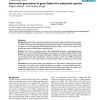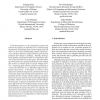41 search results - page 1 / 9 » Gene prediction using the Self-Organizing Map: automatic gen... |
BMCBI
2004
13 years 4 months ago
2004
Background: Many current gene prediction methods use only one model to represent proteincoding regions in a genome, and so are less likely to predict the location of genes that ha...
BMCBI
2006
13 years 4 months ago
2006
Background: The number of sequenced eukaryotic genomes is rapidly increasing. This means that over time it will be hard to keep supplying customised gene finders for each genome. ...
BMCBI
2006
13 years 4 months ago
2006
Background: Horizontal gene transfer (HGT) is considered a strong evolutionary force shaping the content of microbial genomes in a substantial manner. It is the difference in spee...
BIBM
2008
IEEE
13 years 10 months ago
2008
IEEE
In the post-genomic era, the organization of genes into networks has played an important role in characterizing the functions of individual genes and the interplay between them. I...
BMCBI
2010
13 years 4 months ago
2010
Background: S. cerevisiae, A. thaliana and M. musculus are well-studied organisms in biology and the sequencing of their genomes was completed many years ago. It is still a challe...


